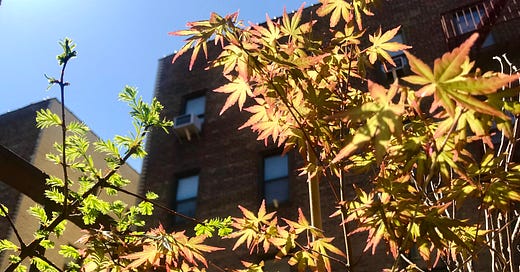To all the newcomers who found Fire Escape Bonsai this week, welcome to tree club, delighted you’re here. This is and will remain a free project, but if you’d like to support my work, tips are greatly appreciated. Hope you enjoy.
In the process of reporting an article about Japanese roasted green tea for the latest issue of Eighty Degrees, I learned of an expression I can’t stop thinking about. In Japanese, it’s nemawashi, or as Zach Mangan of Kettl called it, “tending the roots.” He was describing the lengthy process of trying to convince a famed Kyoto tea shop to allow Zach to buy their tea, to re-sell in the United States. It took four visits to even begin the conversation of a sale, Zach said. He had to earn the owner’s trust, discuss tea and shared values. Only then could he broach the subject in the least assuming way possible: “I think our customers would love this tea.”
Zach had to tend the roots.
When you think of a tree, you think of the crenellations of its bark and complexion of its leaves. But the whole of a tree begins beneath the soil with the roots.
Leaves turn sunlight into sugars for energy. What isn’t used right away travels down the vascular tissue of the trunk into the roots for storage. It’s these roots that anchor the tree to the earth and absorb water and nutrients to feed the growth above the surface. No roots, no tree. If you cut a branch off and stick it into soil, the leaf nodes may shoot out root tissue to make a new tree. It always begins with the roots, unseen and essential.
When training a tree for bonsai, you want to develop a particular system of fine roots extending radially from the base of the tree, in a flat horizontal plane. In nature, trees use these fine roots for absorbing water and nutrients, while relying on thicker, deeper woody roots as anchors and sugar storage. In the petite confines of a bonsai pot, there’s no room for anchor roots. So over the course of many years, you regularly dig up the tree and do some nemawashi: pruning thick roots, combing out dead root fibers, and arranging the filaments to sit well in a pot.
This is critical groundwork for a tree to thrive in a pot. The more fine feeder roots you have in a dense root system, the more nutrients a tree can draw from the soil. That means more resources to sprout new leaves and branches for a dense canopy. Without this ramified root system, you won’t have much luck developing a convincing miniature tree, no matter how good your wiring skills are. On the bonsai forums, you know you have a really nice tree when people compliment your root work.
I bought this hornbeam from an eBay seller a few weeks ago. The tree was pictured growing in a large pot. Without telling me, the seller dug up the tree, wrapped the root ball and some soil in plastic, and shipped it without the pot. If this were winter, that would have been fine, but at this point the tree had come out of dormancy and was pushing out new leaves. Just when it needed its root system the most, the tree was ripped from its home and forced into a strange new environment with only a fraction of its roots intact.
The hornbeam is visibly unhappy. The new leaves have shriveled and new bud growth has slowed to a crawl. I’ve repotted it in a mix of pumace, turface, lava rock, vermiculite, sphagnum moss, and a tiny bit of potting soil, to give the roots plenty of breathing room to reestablish themselves. We’ll see if the tree survives. If it does, it will be thanks to the roots.
Tree reading
Artist Maya Lin’s newest exhibit is a ghost forest of dead trees planted in New York, a spooky-beautiful commentary on the arboreal apocalypse we’re giddily marching towards. [Gothamist]
There’s a good chance that your streets are currently alive with the smell of, uh, semen. Thank the invasive Bradford pear. [Cincinnati City Beat]




